If you’ve ever been interested in playing Blizzard Entertainment’s collectible card juggernaut Hearthstone: Heroes of Warcraft but never jumped in, now is a great time to give it a try.
This week, new players have a bit easier time getting started. Several decks poofed from that mode, meaning that you’re not as far behind veteran players than you think you are. The new mode limits players to cards released in the past two years, and to classic cards from the very start of the game. It’s how Blizzard is attempting to keep Hearthstone fresh and engaging for veterans while still making it less intimidating for new players — a key strategy in the new $1.2 billion card game market. Hearthstone’s the leader here, making $20 million a month, according to SuperData.
You can also pick up 13 free card packs just for trying the game this week, thanks to the launch of the Whispers of the Old Gods expansion.
“For beginners it won’t be a big change,” said Hearthstone senior designer Mike Donais. “All of their Basic and Classic cards are still fully playable in Standard. Standard is a great format for them because they don’t need to worry about buying or learning about [Goblins vs. Gnomes expansion] and Naxxramas [adventure] cards.
AI Weekly
The must-read newsletter for AI and Big Data industry written by Khari Johnson, Kyle Wiggers, and Seth Colaner.
Included with VentureBeat Insider and VentureBeat VIP memberships.
“Everyone will be experimenting with new deck ideas in Standard, which is a great time to be a new player.”
But you’ve never played a collectible card game, let alone Hearthstone, you say. No problem! Just four short months ago, I was there with you: I had played three games to get the shiny horse in World of Warcraft (don’t judge), but I then dropped it again immediately. I’d never played a CCG before, ever.
So when I started again in December, I was still well and truly noob. I made a ton of mistakes, and met a bunch of far more experienced players who helped me to figure the game out. Hearthstone has ranks from 25 (worst) to 1 (best), and above that, Legend ranks count upward for competitive tournament players.
In about two months, I made rank 13 (roughly the top 25 percent of Hearthstone players,) and I’ve hit that level fairly consistently in the past few seasons. So can you. Here’s how.
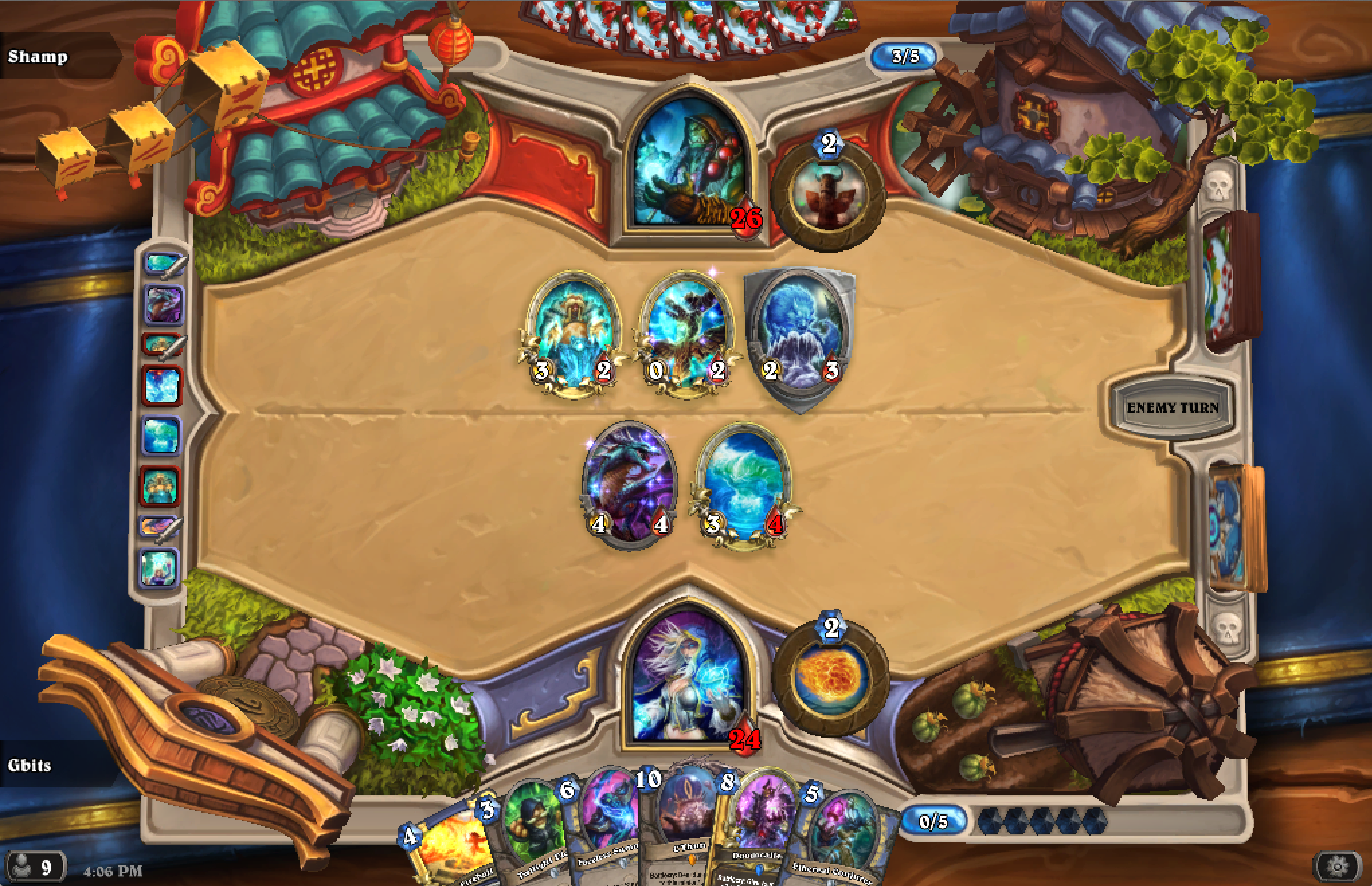
Above: A Hearthstone game in progress.
OK, so how does this thing work?
Each player in Hearthstone has a hero. Get your opponent’s hero from 30 health at the start to zero health and you win. Let your own hero get to 0 and you lose.
Before you play, you’ll select a deck of 30 cards. You can choose what type of hero you want to play – Mage, Shaman, Paladin, Priest, Hunter, Warrior, Warlock, or Druid. You start with premade decks, and this is a blessing. Stick with that until you get better.
You can play against the computer A.I. or against human beings. Hearthstone is family-friendly; you can’t actually chat with other players (unless you request to be friends with them or vice versa.) Instead, you can use “emotes” – limited phrases, like “Wow!” or “Oops” or “Hello.”
Your deck will have minions, which become little creatures on the playing board, and spells, which you can use to make your own minions stronger, other minions weaker, do damage, heal things, and a variety of other effects. You will take turns with your opponent, playing cards.
Each class has a particular “hero power” – a basic ability that you don’t have to get a card to use. Paladins can summon little guards with 1 attack and 1 health, for example. Priests can heal two points of health. Warlocks can draw an extra card, sacrificing 2 points of health to get more resources. And so on.
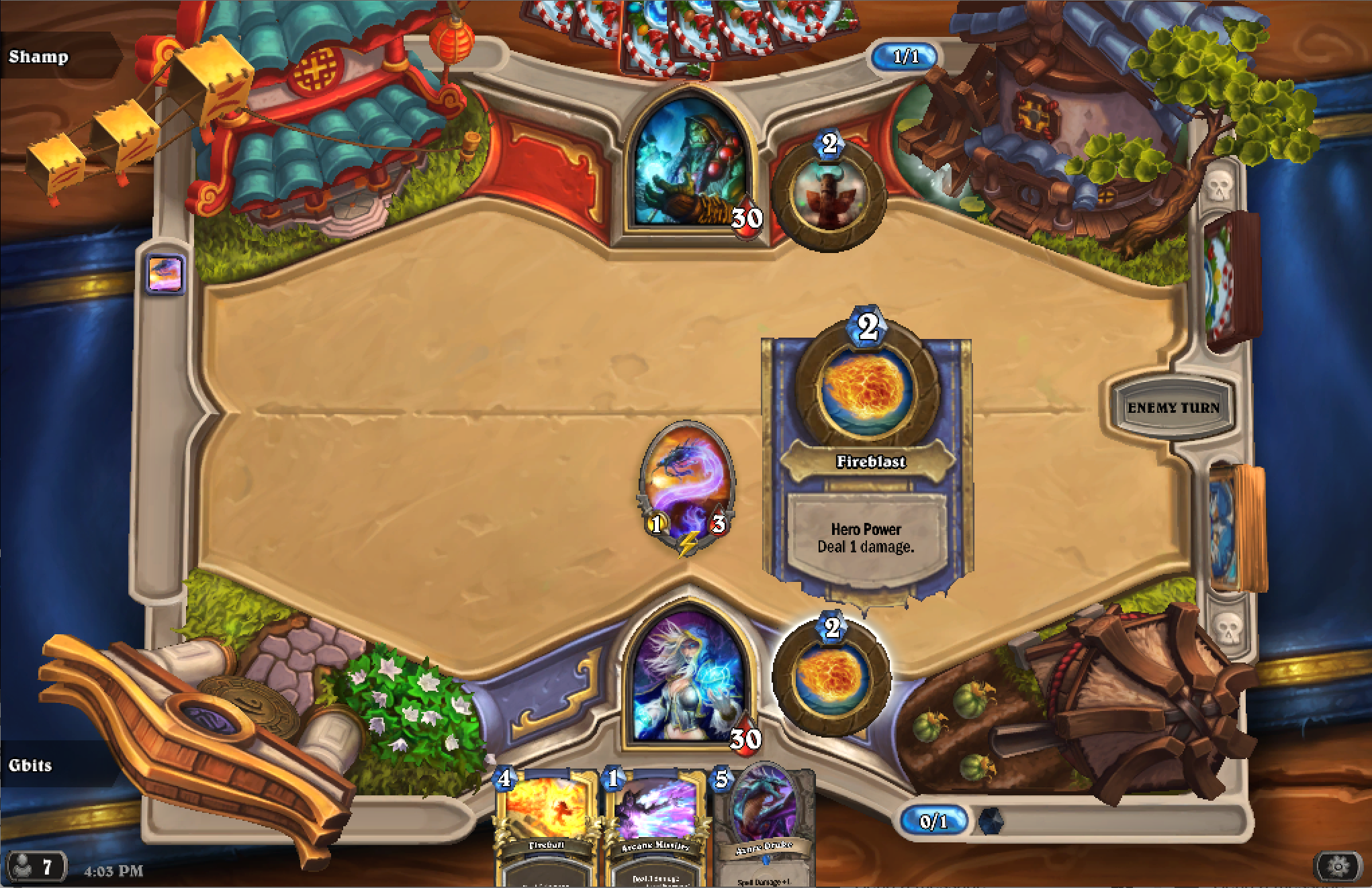
Above: The mage’s Hero Power is tossing a 1 damage fireball at any minion or the opposing hero.
At the start, you will have three or four cards for your hand. You can choose to reject some or all of them, and other cards from your deck will replace them.
In general, look for low-cost minions to start the match. If you don’t have any, click on the highest-cost cards you’ve been dealt to get rid of them and try for a lower card.
You will either receive three cards, in which case you go first, or four cards, in which case you’ll receive “The Coin” – a 0-mana card that gives you an extra point of mana. Mana is what limits how many cards you can play each round. Each player starts with 1 mana, and the amount increases each round of play until both are capped at 10.
Each round, Hearthstone will deal another card for your hand, and you can choose to play whatever cards you have the mana for.
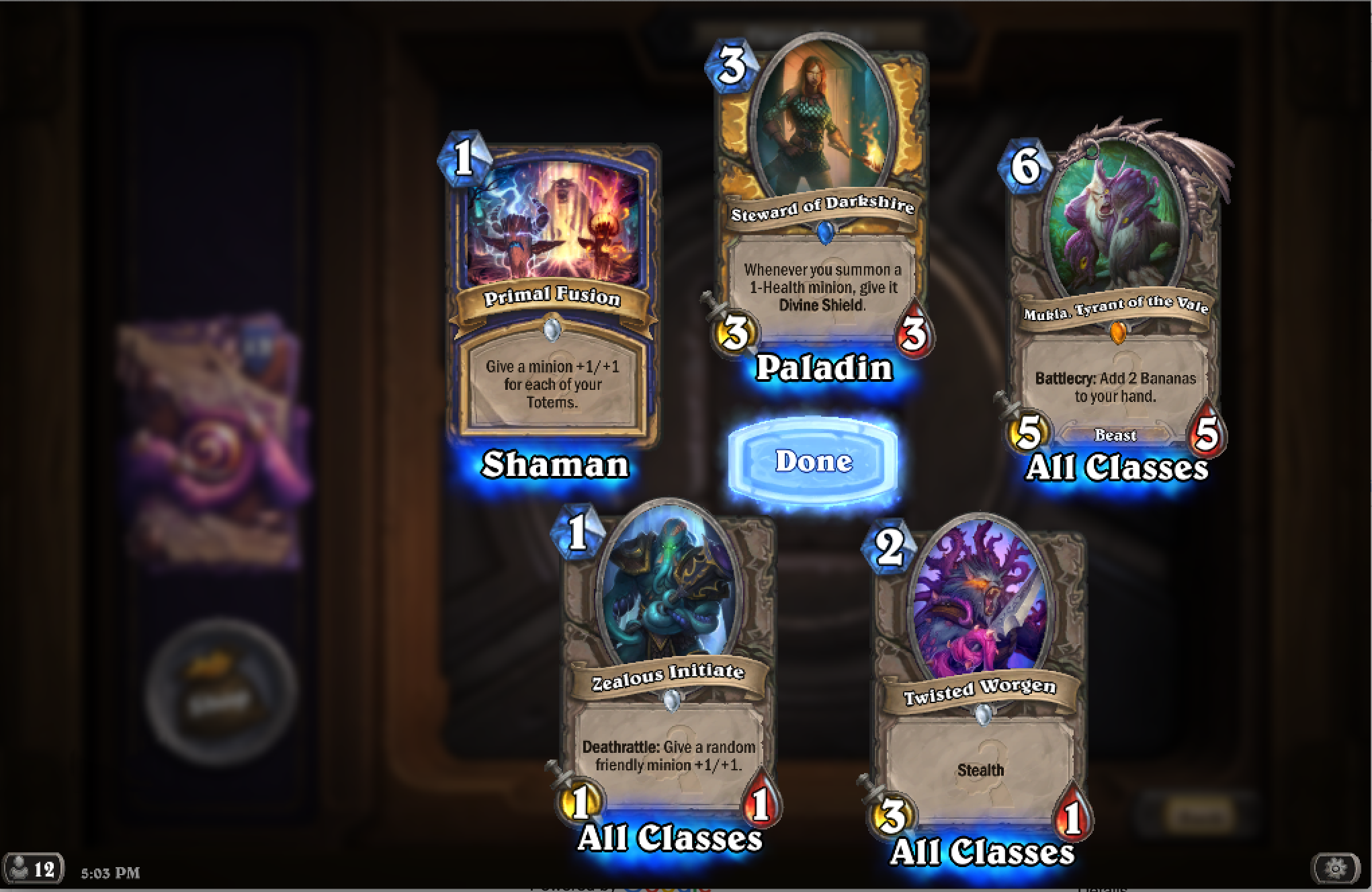
Above: Five cards from a new Whispers of the Old Gods expansion pack. Four are minions; the one with the fancy outline is Legendary.
More about minions
Minions can’t attack in the turn you play them, unless they have “Charge” as an ability (which enables them to go on the offensive when they hit the board). Most will sleep until the next round, when you can use them to do damage against other minions or the enemy hero.
Minions can have all kinds of effects; it’s worth scrolling through the lists of cards available online to browse and see them all. Many are “Battlecry” cards, which trigger a particular effect when you play them. Others are “Deathrattle” cards, that do something nifty when they die, like summon a weaker minion or dealing out damage.
Some minions have “Taunt,” which is kind of like a shield or a wall. You must destroy it before your minions or weapon can attack your opponent’s other cards or hero (Taunt doesn’t stop spells, though).
Some minions and spells can “Silence” on other minions, removing buffs they’ve received and taking away their ability to cast Deathrattle effects or to affect other cards.
A minion who is attacked does its damage to whatever is attacking it, as well as whatever you make it attack. So be careful that you don’t batter your little minions to death against stronger minions that your opponent may play.
Minions and spells are ranked by how rare they are. White is common; blue, rare; purple, epic; and orange, Legendary. You can tell the rarity of a card by the color of the gem in its center. Legendary cards also have dragon portraits around them; they’re hard to miss.
OK, so that doesn’t seem too hard. So how do you get started?
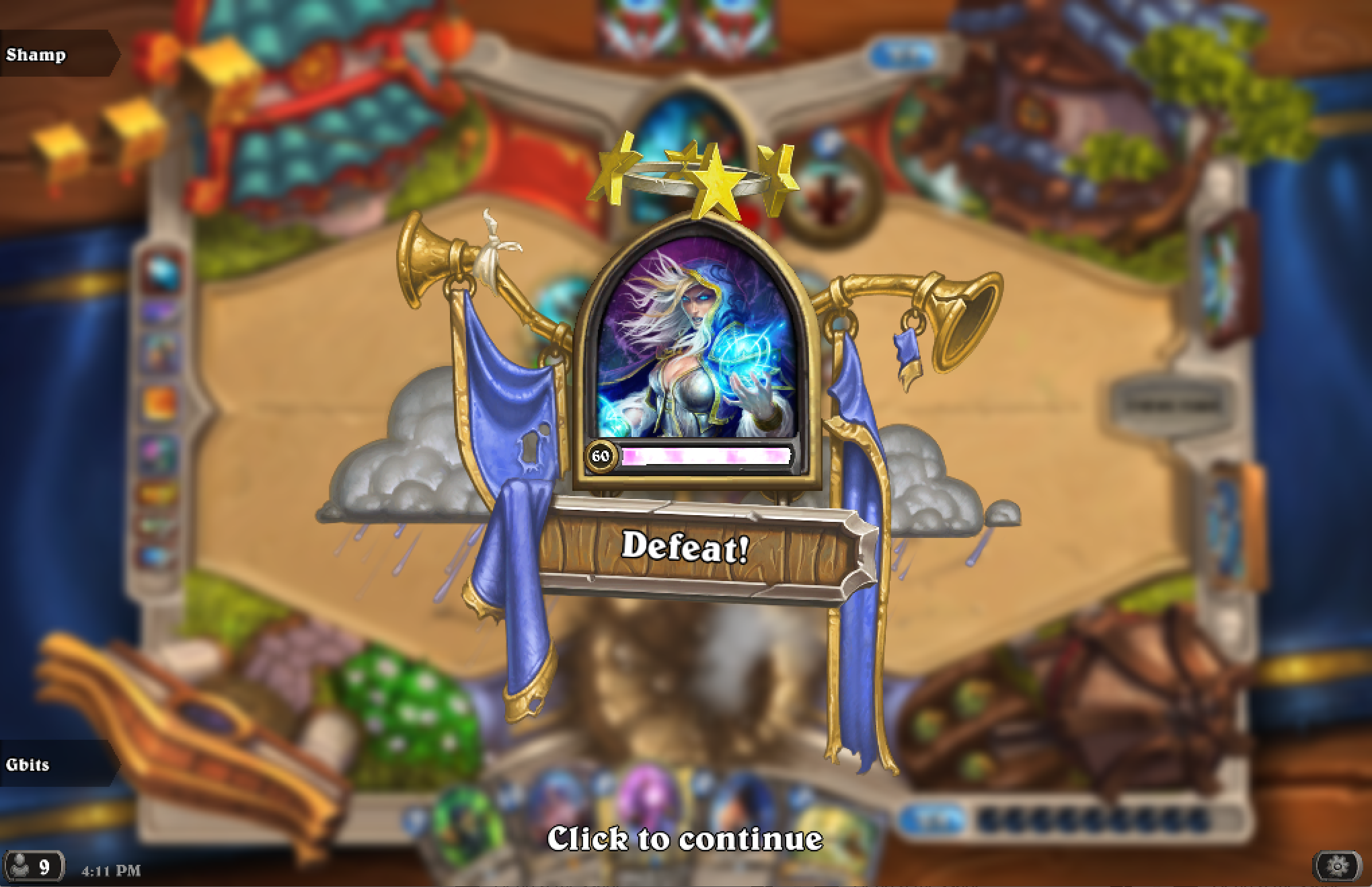
Above: Get used to seeing this … a ton.
Lose. A lot
Assuming you’d like to dive into Hearthstone without spending any money, you’re going to start without any good cards. You get enough to play, but they’ll be an extremely basic selection. On the bright side, you won’t have to worry much about how to build a deck, because you won’t have many choices.
On the down side, you’re going to get your teeth kicked in.
So embrace your loser status. Don’t play against the A.I.; tackle real people. That’s how you’ll learn and get better. And go ahead and jump into ranked mode as quickly as possible. Man, are you going to die. But you’ll learn more there, from players who care about the game.
You have one job: Play enough games so that you level all the different types of heroes to 20. This bags you all their basic cards. You’re going to need them all at one time or another. Start by leveling a single hero to 20 first so you can do Tavern Brawls as quickly as possible (more on that in a minute.)
Even when you lose, your hero gains experience, and the more experience you earn, the more cards you’ll unlock. You earn more experience playing against other players than you do playing the A.I.
Do play Standard Mode (rather than Wild, which allows cards from all expansions and adventures.) You’ll earn your 13 free packs from the new expansion that way, albeit very … very … slowly, since you won’t be winning often.
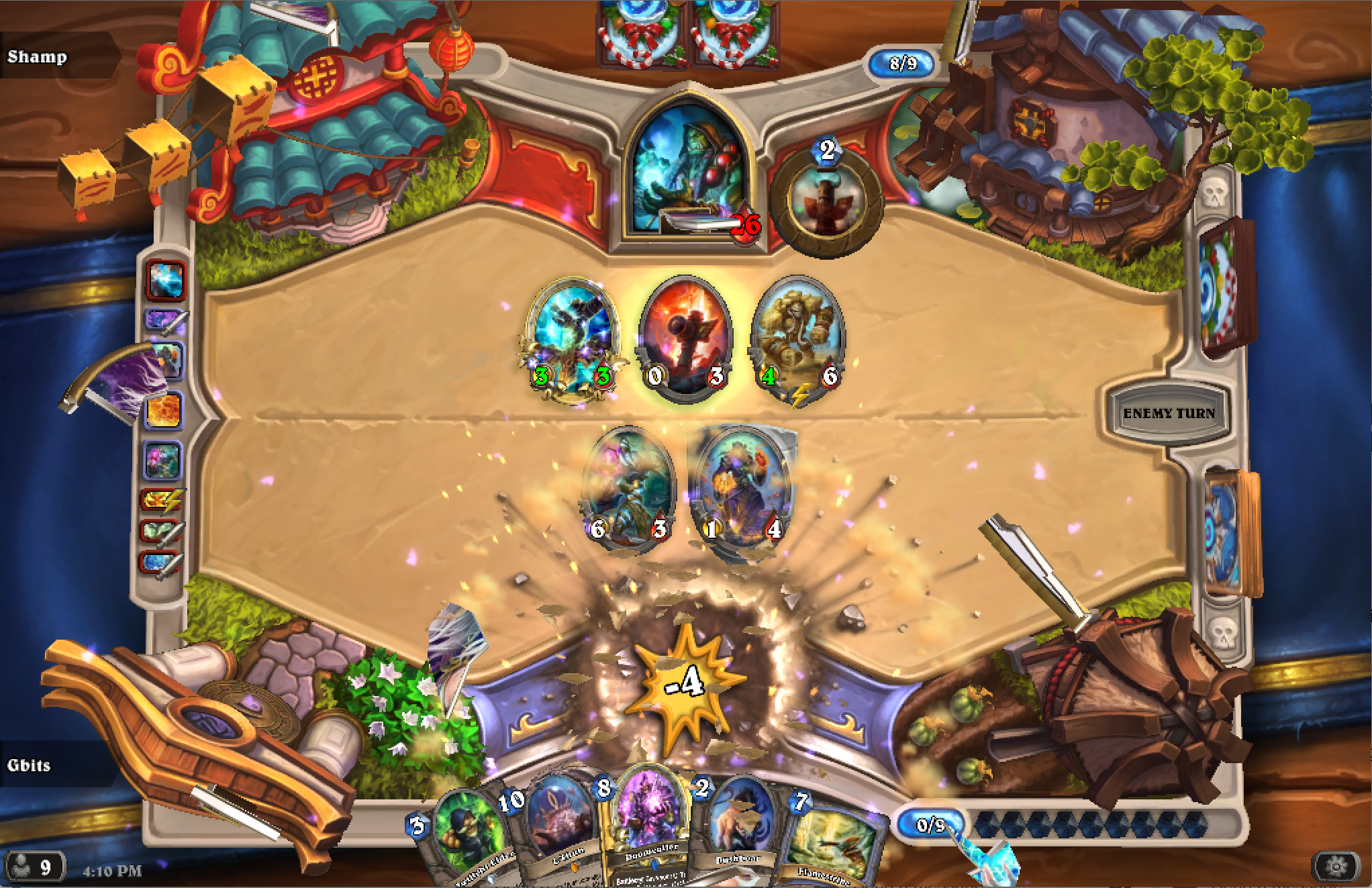
Above: Ouch. This game ended poorly for my Mage. I learned a few things about how to play a shaman from my opponent, however.
Learn. A lot
While you’re busy getting creamed, watch closely as other people play their cards. Some will be idiots, but many will show you how one card can influence another, buffing or multiplying their effects.
One minion might do damage when you summon other minions; another spell might summon multiple minions, causing the first card to do a decent bit of damage. And so on. You’ll learn by watching. Take notes.
But don’t just learn by watching your own opponents. If you have more-experienced Battle.net friends who play Hearthstone, spectate their matches as well. (Bonus: You sometimes get a quest for that.)
And watch the pros. I asked top Hearthstone player Brian “B.M.” Kibler what his one tip for newbies would be.
“There are a lot of resources available for new Hearthstone players to learn,” he said. “Some of the best are probably Twitch and YouTube channels of players who explain their decisions as they play, like Trump and Strifecro — or myself, if I’m into shameless self-promotion.”
I’d second his vote for Trump in particular; a veteran player tipped me off to his videos early, and they are both clear for new players and fun to watch. And Kibler is a truly nice guy, in addition to being a cracker-jack player and a Hearthstone commentator, which makes him a terrific one to watch as well.
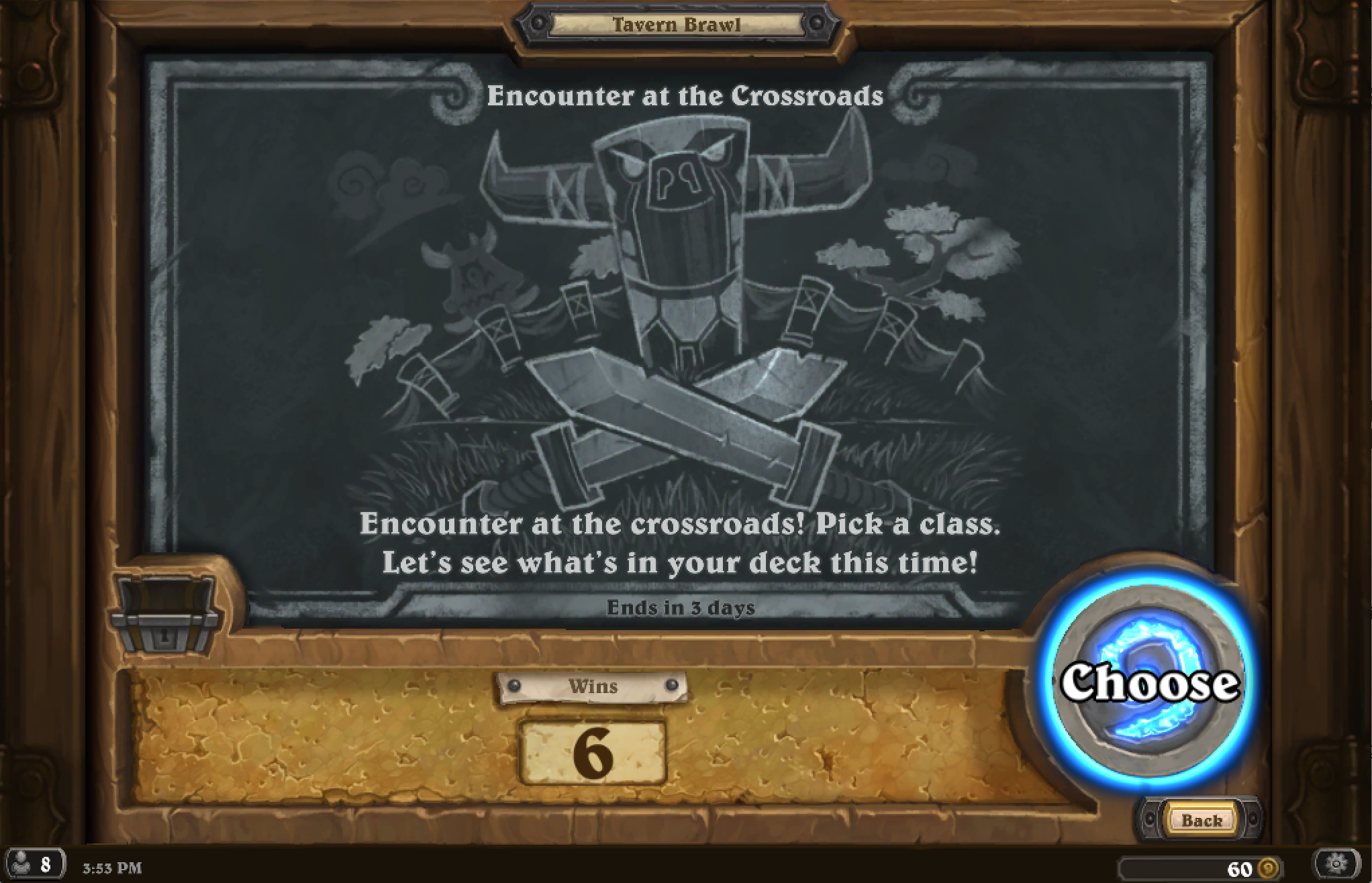
Above: This week’s Tavern Brawl.
Get Brawling
Once you have one hero to level 20, you can play in Tavern Brawls. These are fun contests with super-weird rules that change every week, and the first game you win in each Brawl earns you a free pack of five Classic set cards.
Many Tavern Brawls give you random or premade decks. Some require you to build a deck. You probably haven’t done that yet, so break out those Googling fingers and search for the name of the Brawl you’re doing and “basic decks.” You’ll find a ton of options, and the “basic” will limit it to cards you have in hand. Literally.
Hearthstone gives you daily quests to win with particular heroes, or by playing particular types of cards. Those quests earn gold, which you can use to buy card packs, and they earn it more quickly than the 10-gold-for-three-wins that you are probably painfully hobbling along with at this point.
Tavern Brawls are terrific places to earn that gold, because they’re much more dependent on randomness (known as RNG, or random number generator, in the community), and your lack of any decent cards is less of a handicap. You can finish Quests in Brawls, as well as in any regular play against humans.
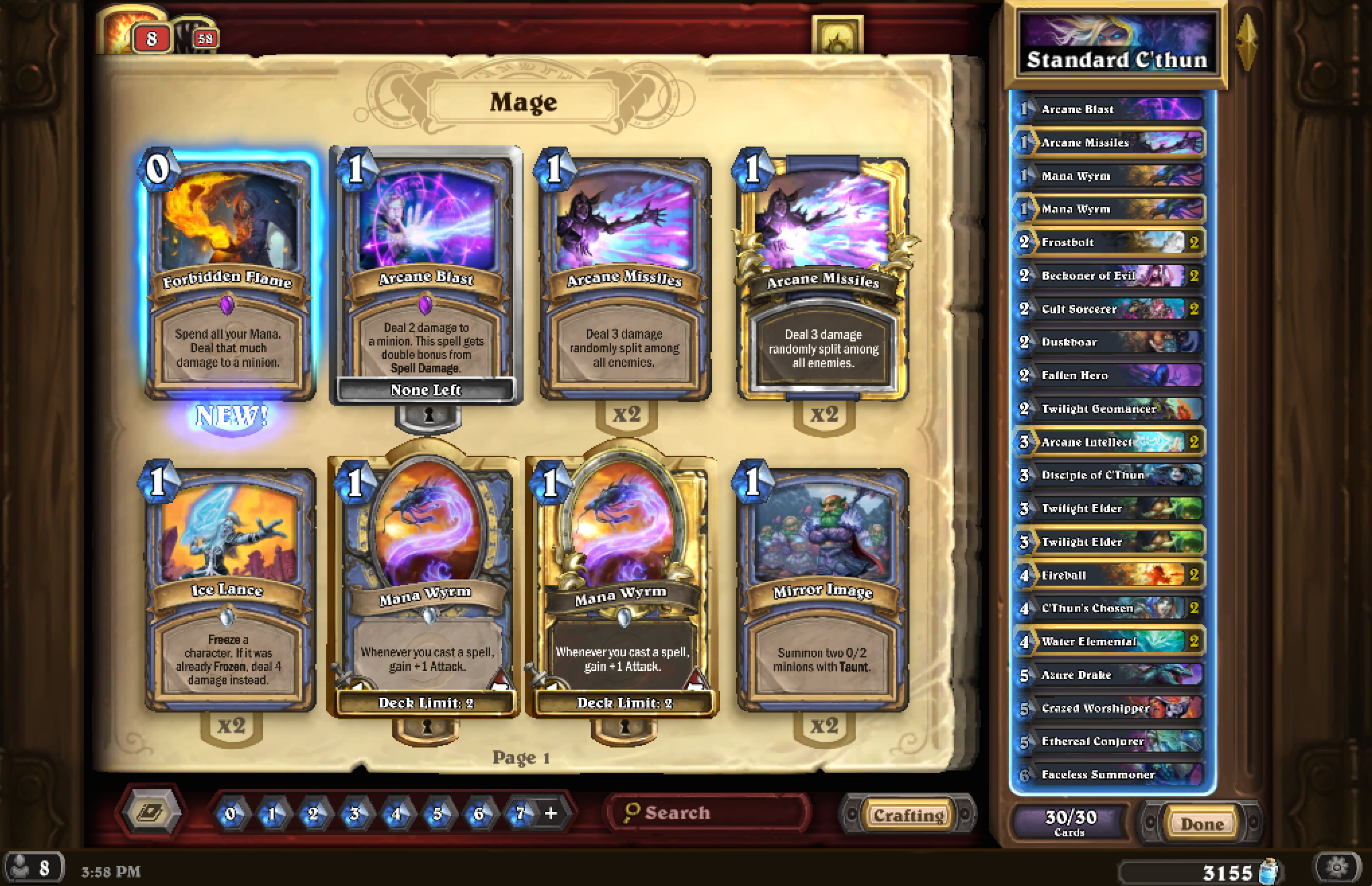
Above: Composing a deck involves picking cards from your collection, at left, and putting them into a 30-card deck list, at right.
Learn to build decks – or copy other people’s lists
I’ll admit something: I’m a much, much better Hearthstone player than I was four months ago. But I still can’t build a good deck.
I understand the theory. You want minions that cost different amounts so you don’t run out of cards too quickly or have to sit, waiting, with giant-cost cards idling in your hand that you don’t have the mana to play.
You want to include cards that have good synergy, playing off each other, and some that are good counters to the tactics other players use most. With the launch of the new Whispers of the Old Gods expansion, counters typically include some kind of transformation or instant-minion-kill card to deal with players using the powerful new C’thun board-killing monster card from the new expansion. (More on that in a second.)
But this is really the place where not having CCG experience will bite you. Never fear, fair Googler; let your fingers do the walking. You can find a huge assortment of Hearthstone decks out there, tested and tuned by more experienced players, and you can experiment until you find a balance that works for you.
Hint: I named two of my favorite decks “Kibler,” and not coincidentally.
Just be sure to search for “Standard Mode” decks or “Whispers of the Old Gods” decks so that you’re up to date on the latest cards.
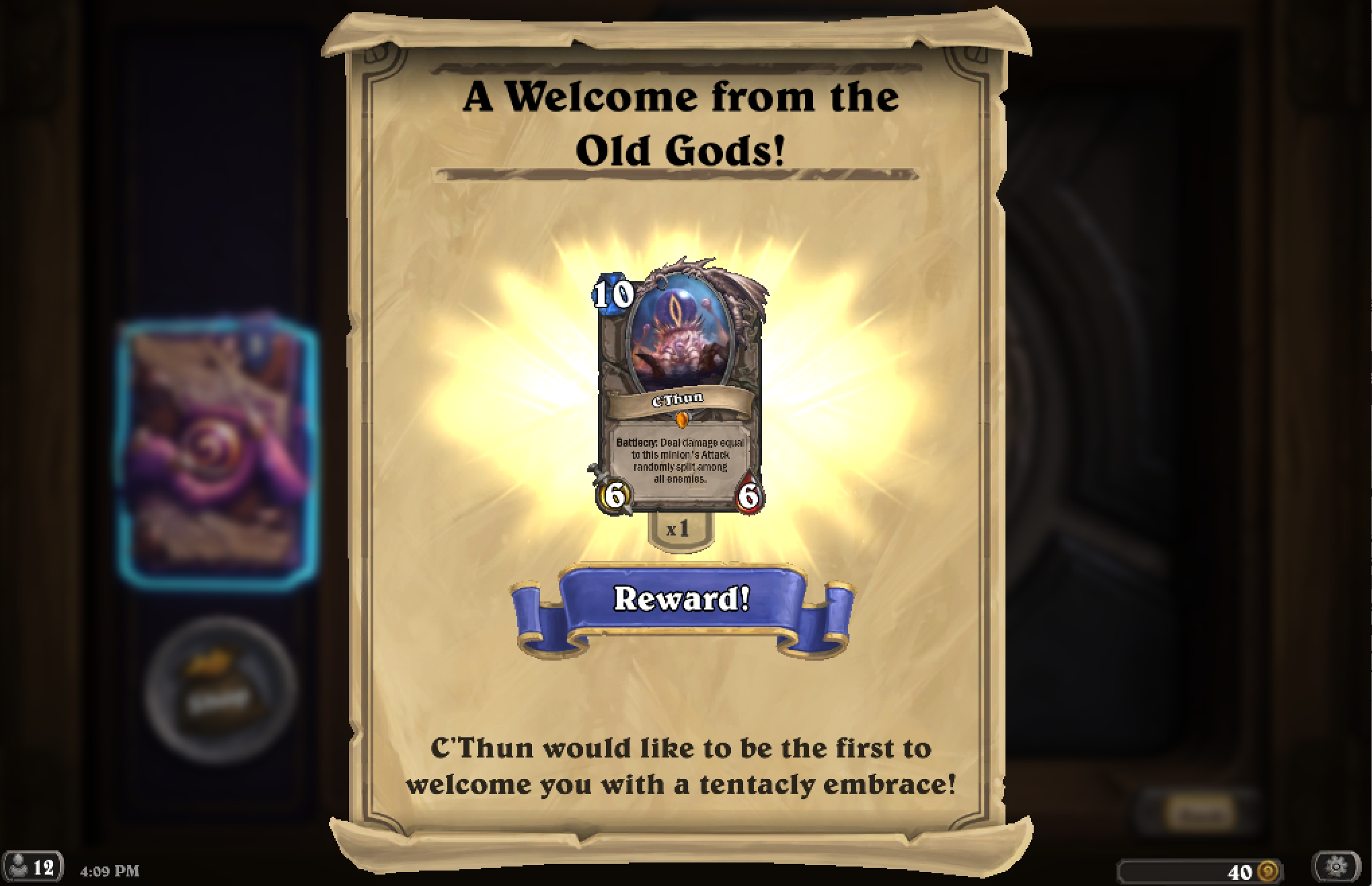
Above: The new C’thun Legendary card is yours free for playing.
Be choosy when buying cards
At least to start, it’s probably worth burying all the gold you earn back into buying card packs. You’ll spend 100 gold to buy a five-card pack. If you decide you love this game, you can spend money on packs, typically paying roughly $1.50 a go.
My advice is to sink all of it into Classic cards and cards from the new expansion, which will remain viable the longest. Because you’ll get at least one free Legendary minion (C’thun) as you play the new Standard Mode, it probably makes sense to devote a good chunk of your gold to the cards from the Whispers of the Old Gods packs, as many of them buff C’thun as you play.
